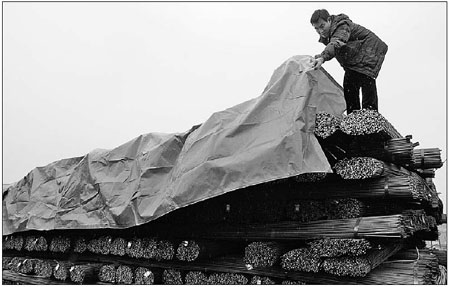Business
Steel industry plan forged
Updated: 2011-01-27 07:10
By Zhang Qi (China Daily)
|
A worker loads steel bars at a steel market in Taiyuan, Shanxi province. The draft of China's 12th Five-Year Plan (2011-2015) gives priority to increasing the concentration of the fragmented steel industry. Shan Qing / for China Daily |
Restructuring seen as key to improvements in manufacturing
BEIJING - China's top 10 steel mills will be able to contribute 60 percent of the country's total steel output and 40 percent of the nation's steel production will come from coastal areas in the 12th Five-Year Plan (2011-2015) period, said an official who was involved in working out the blueprint for the nation's steel industry, which is set to be finalized soon.
A draft of that plan highlighted the priorities of increasing the concentration of the scattered steel industry, upgrading the industry technology, eliminating outdated capacity and encouraging steel companies to move to coastal bases, said an official from China's steel lobby, China Iron & Steel Association (CISA), who wished to remain anonymous.
For several years, the nation has been encouraging big mills to merge with rivals to create more cohesive steel groups in an effort to address overcapacity, pollution and a disadvantageous position in price negotiations for iron ore.
China, the world's largest steel producer and iron ore consumer, has less say in annual price talks with the big three global miners - Vale, BHP and Rio Tinto - because of the low concentration of its steel industry.
Media reported earlier this month that BHP has moved to a monthly set pricing after the three miners abandoned a 40-year tradition of annual iron ore negotiations in March and turned to quarterly pricing.
Hu Kai, an analyst from Umetals.com, said Chinese steel companies have to pay an extra $200 million this January for iron ore imported from BHP since it made that shift.
The central government aims to create several steel giants with an annual production capacity of over 50 million tons through mergers and acquisitions to reverse the situation.
Hebei Iron and Steel Group Co Ltd, China's biggest steelmaker by output, said in January that it agreed to take 10 percent stakes in seven private steel mills to expand its production capacity and increase consolidation in Hebei province.
Hebei province- where 60 percent of the capacity comes from small private steel mills - is drafting a plan to reduce the number of its steel mills from 88 to 10 during the next five years.
The official from CISA said that because of increasing environmental pressure and the need to control logistical costs, the central government plans to gradually move its steel production to coastal areas.
According to the official, the government will accelerate the restructuring of the steel industry that is focused on China's coast - with Anshan Steel in Liaoning province; Shougang in Caofeidian, Hebei province; Baosteel in Zhanjiang, Guangdong province; and Wuhan Iron and Steel Group in Fangchenggang, in the Guangxi Zhuang autonomous region.
For instance, China's second-largest steelmaker by output, Baosteel, is expected to acquire Guangdong steel enterprises as part of its Zhanjiang project plan, a steel-production base with a planned annual capacity of 10 million tons along the coast of Guangdong province.
The official also said the 12th Five-Year Plan will highlight the preparation of new coastal bases in Fujian and Jiangsu provinces.
Another target of the plan is to increase the proportion of Chinese steelmakers' self-supplying of iron ore by expanding domestic ore production and acquiring more overseas resources, he said.
Chinese steelmakers have been looking in recent years for more overseas ore assets to cut their reliance on expensive imports.
Deng Qilin, chairman of China's third-largest steelmaker, Wuhan Steel, said his company will become self-sufficient in iron ore supplies in the next five years.
China's domestic iron ore supplies have been rising for the last two years. During the first nine months of 2010, domestic iron ore output jumped 26 percent year-on-year to 780 million tons.
Domestic iron ore output is expected to exceed 1.3 billion tons within three to five years, said Zhou Zhongshu, president of China Minmetals Corp.
China Daily
(China Daily 01/27/2011 page14)
Specials

President Hu visits the US
President Hu Jintao is on a state visit to the US from Jan 18 to 21.

Ancient life
The discovery of the fossile of a female pterosaur nicknamed as Mrs T and her un-laid egg are shedding new light on ancient mysteries.

Economic Figures
China's GDP growth jumped 10.3 percent year-on-year in 2010, boosted by a faster-than-expected 9.8 percent expansion in the fourth quarter.
